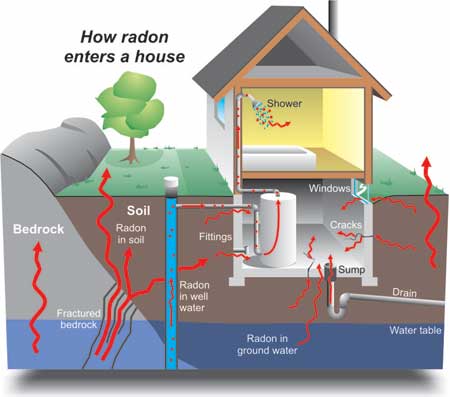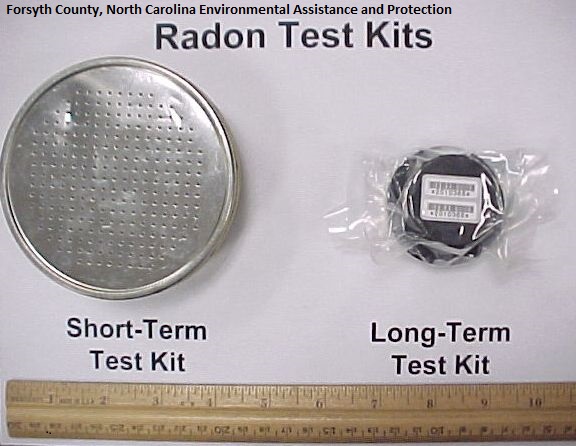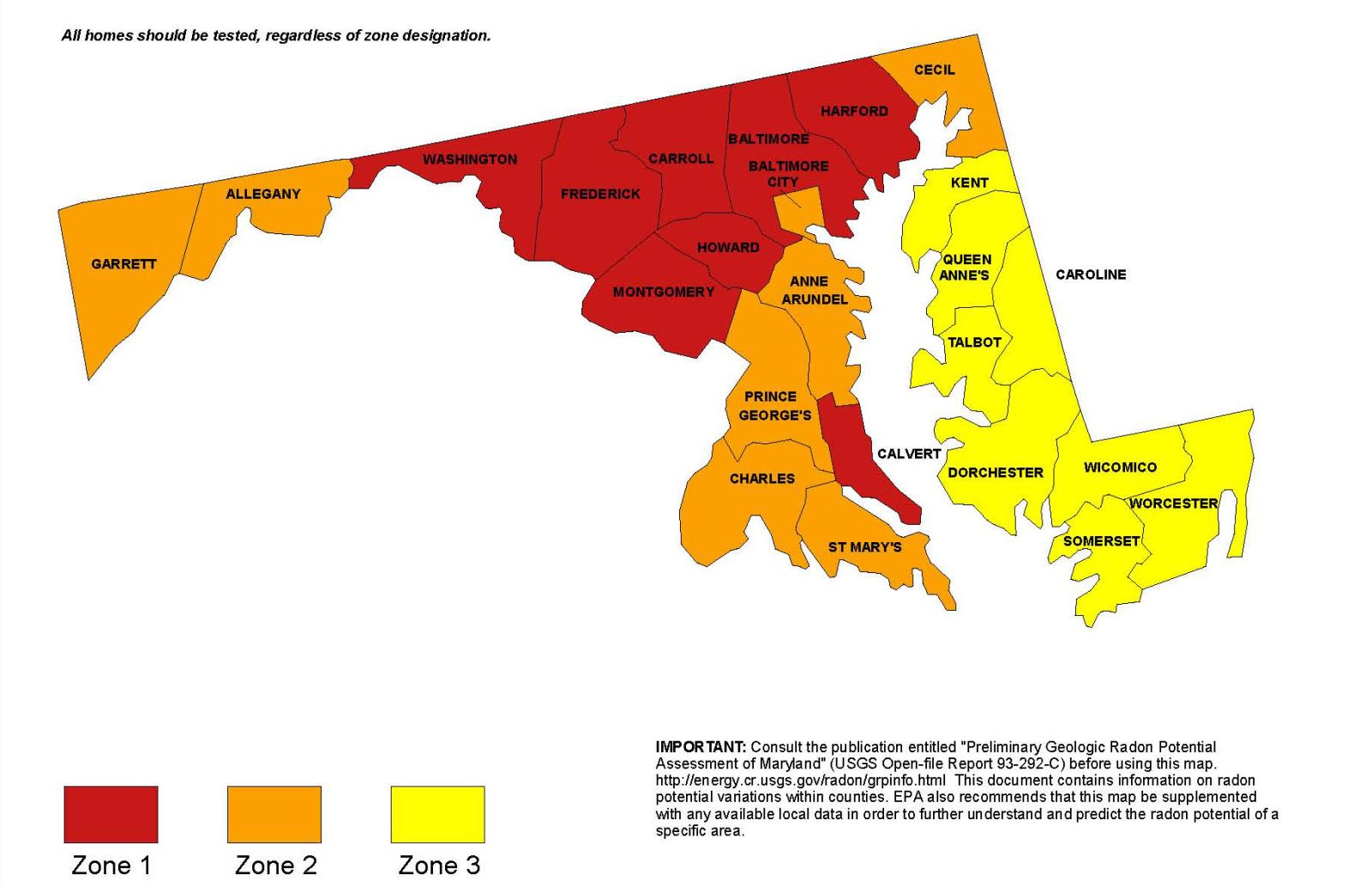Radon
Radon is an invisible, radioactive gas created during the natural breakdown of uranium in rocks and soils. It is found in nearly all soils. Radon typically moves up through the ground and into homes and buildings through cracks and other holes in the foundation, although there are other radon sources.
Radon usually does not present a health risk outdoors because it is diluted in the open air. Radon can, however, build up to dangerous levels inside a house.
Download the radon handout (PDF)
Order a Radon Test Kit
Visit the Maryland Department of Health $3 Discounted Radon Test Kit Offer website (while supplies last) or contact a nearby home improvement store to purchase a radon test kit.
Radon Testing and Mitigation for Rental Properties
As of July 1, 2023, Montgomery County law requires radon testing for multifamily (including condominiums) and single-family rental housing, as well as disclosure and mitigation of radon hazards above a certain action level. This requirement is administered by the Department of Housing and Community Affairs. The DHCA website contains information for landlords and tenants.
The Radon and Home Building Law
As of October 1, 2016, County law requires that “a single-family home located in the County must be tested for radon before completing a sale of the home.” Learn more about the law as well as information for those building a new home. Visit our Radon and Buying or Building a home page.
What Areas are at Risk for Radon?
Montgomery County, MD has high levels of radon in the soil, and therefore, every home in Montgomery County should be tested for radon.
The U.S. Environmental Protection Agency (EPA) has worked with state and federal geologists to develop maps which predict the potential indoor radon levels for every county in the United States. Those counties with the highest potential are designated as Zone 1; those with the lowest comprise Zone 3.
Montgomery County, MD has been designated as a Zone 1 area which means there is a predicted average radon level at or above the EPA's 4.0 pico-Curies per liter (pCi/L) action level. (pCi/L is a measure of the amount of radioactivity in a known quantity of air.)
Health Effects of Radon Exposure
Breathing air that contains radon can cause lung cancer. In fact, the United States Surgeon General has warned that radon is the second leading cause of lung cancer in the United States today, and is the leading cause of lung cancer in nonsmokers. If you smoke and your home has high radon levels, your risk of lung cancer is especially high.
According to the U.S. Environmental Protection Agency (EPA), radon is estimated to cause about 21,000 lung cancer deaths per year. Detailed information about the health effect of prolonged radon exposure can be found on the EPA's Radon Health Risks Webpage.
Learn about Radon
Potential Sources of Radon
There are three main ways that radon can accumulate in your home:
Entry through the Foundation and Building Envelope
Radon can enter a home from the soil beneath a home through cracks and other openings in a building's foundation. Entry points in a building envelope (foundation, floor, walls, and roof), can include cracks in concrete floors and walls, construction joints, gaps around service pipes, and other penetrations through foundations and walls.
Although newer houses, (those built after 1995 in Montgomery County) are built to resist radon entry through the use of certain construction techniques, the only way to ensure that radon is not entering the house is to conduct a radon test.
Water Supply
The potential radon risk from water is generally much less than from entry of radon through a building's foundation. Radon in your home's water is not usually a problem when the water source is surface water. A radon problem is more likely when the source is groundwater (e.g. private well, or a public water supply system that uses groundwater).
- If you are concerned that radon might be entering your home through the water and your water comes from a public water supply, contact your water supplier.
- For those private wells/well water, it is recommended that you test your water for radon. Visit the Maryland Department of the Environment for a list of certified water testing labs.
The radon in your water supply poses an inhalation risk and an ingestion risk. Research has shown that your risk of lung cancer from breathing radon in the air is much greater than your risk of stomach cancer from swallowing water with radon in it. Most of your risk from radon in water comes from radon released into the air when you use water for showering and other household purposes.
Building Materials
Certain building materials, most notably granite countertops, can be a source of radon. However, according to EPA (PDF), building materials rarely cause radon problems by themselves, and EPA believes that the existing data is insufficient to conclude that the types of granite commonly used in countertops are significantly increasing indoor radon levels. Learn about radon and building a new home.
 Natural Resources Canada
Natural Resources CanadaTesting for Radon
All homes in Montgomery County should be tested for radon.
Information on radon testing and what to do if a test indicates a radon problem exists in your home is summarized below. Much of this information is adapted from EPA's publication entitled A Citizen's Guide to Radon (PDF).
Are you buying, selling, or building a home in Montgomery County? Learn about the County laws regarding radon testing.
There are two basic ways to test for radon: short-term testing and long-term testing. Do-it-yourself radon test kits of either type are available through the mail or from hardware stores and other retail outlets. Carefully read and follow the instructions for using the test kit regardless of the type used.
- Short-Term Testing
The quickest results are achieved with a short-term test. Short-term tests remain in your home for 2 to 90 days, depending on the device. Charcoal canister detectors are the most commonly used short-term testing devices. Because radon levels tend to vary from day to day and season to season, a short-term test is less likely than a long-term test to tell you your year-round average radon level. But if you need results quickly, you can use a short-term test followed by a second short-term test to decide whether any remediation is needed to address high radon levels.
- Long-Term Testing
Long-term tests remain in your home for more than 90 days. "Alpha Track" and "electret" detectors are commonly used for this type of testing. A long-term test will give you a reading that is more likely to tell you your home's year-round average radon level than a short-term test.
The amount of radon in the air is measured in picocuries per liter (pCi/L). Sometimes test results are expressed in working levels (WL) rather than in picocuries per liter (4 pCi/L = 0.016 WL).
EPA recommends that you fix your home if the radon level is 4 pCi/L or more. Because there is no known safe level of exposure to radon, EPA also recommends that you consider fixing your home if the radon level is between 2pCi/L and 4 pCi/L. EPA's estimate of 21,000 lung cancer deaths per year due to radon is based on the average radon concentration in American homes, which is about 1.3 pCi/L. The average concentration of radon in outdoor air is 0.4 pCi/L, or 1/10 of EPA's 4 pCi/L action level.

Order a Radon Test Kit
Visit the Maryland Department of Health $3 Discounted Radon Test Kit Offer website (while supplies last) or contact a nearby home improvement store to purchase a radon test kit.
Some home improvements stores sell radon test kits. Follow the directions on the packaging for proper placement of the device and where to send the device after the test to get your reading.
EPA Recommended Testing Steps
The higher your initial short-term test results, the more certain you can be that you should use a short-term rather than a long-term follow-up test. If your first short-term test result is more than twice the EPA's 4 pCi/L action level, you should do a second short-term test immediately.
If you followed up with a second short-term test, the higher your short-term results, the more certain you can be that you should fix your home. Consider fixing your home if the average of your first and second test is 4 pCi/L or higher.
- Do a short-term test. If the result is 4 pCi/L or higher, proceed to step 2 to be sure.
- Follow up with a long-term test or a second short-term test:
- For a better understanding of your year-round average radon level, do a long-term test.
- If you need results quickly, conduct a second short-term test.
- If you followed up with a long-term test, fix your home if your long-term test result is 4 pCi/L or more.
Reducing High Radon Levels
You have tested your home for radon, but now what?
If you have tested your home for radon and confirmed that you have elevated radon levels, 4 picocuries per liter in air (pCi/L) or higher, the following guidance can help you:
- Select a qualified radon mitigation contractor to reduce the radon levels in your home.
- Determine an appropriate radon reduction method.
- Maintain your radon reduction system.
Radon reduction systems work. Some radon reduction systems can reduce radon levels in your home by up to 99 percent. Most homes can be fixed for about the same cost as other common home repairs. Your costs may vary depending on the size and design of your home and which radon reduction methods are needed. Get an estimate from one or more qualified radon mitigation contractors. Hundreds of thousands of people have reduced radon levels in their homes.
Radon Mitigation Systems
There are several proven methods for reducing radon in your home, but the one primarily used is a vent pipe system and fan, which pull radon from beneath the house and vent it to the outside. This system, known as a soil suction radon reduction system, does not require major changes to your home. Sealing foundation cracks and other openings makes this kind of system more effective and cost-efficient. Similar systems can also be installed in houses with crawl spaces. Radon contractors can use other methods that might also work in your home. The right system depends on the design of your home and other factors.
EPA's Consumer's Guide to Radon Reduction (PDF) provides information on how to select the right contractor to install a radon reduction system, what to look for in a contract, different types of reduction systems, and other information to ensure the system you install meets your needs.
Certified Radon Contractors
If you would like to hire a contractor to perform the testing or to install a mitigation system to reduce radon in your home, you should first contact one of the independent radon proficiency programs below. They have a list of the certified radon contractors serving your area. The websites for these organizations have a contractor search feature that enables consumers to find professionals certified in testing and/or remediation.
American Association of Radon Scientists and Technologists
National Radon Proficiency Program
Website: American Association of Radon Scientists and Technologists
Email: [email protected]
Phone: (800) 269-4174
National Radon Safety Board (NRSB)
Website: National Radon Safety Board
Email: [email protected]
Phone: (866) 329-3474
Radon FAQs
Are radon measurements accurate and reliable?
Radon measurement systems provide practical and affordable measurements that can give consumers the information they need about the radon level in their home in order to make a decision about whether to fix their home.
How do I get a radon test kit?
Maryland Department of Health $3 Discounted Radon Test Kit Offer (while supplies last). You can also purchase test kits from home improvement stores and online marketplaces. View the Testing for Radon dropdown (above) for more information.
How can you find a qualified radon service provider in your area?
If you would like to hire a contractor to perform the testing or to install practices to reduce radon in your home, you should first contact one of the independent radon proficiency programs. View the Reducing High Radon Levels dropdown (above) for more information.
Explain working levels (WL) and picocuries per liter of air (pCi/L)
Your radon test results may be reported in either picocuries per liter of air (pCi/L) or working levels (WL).
- If your test result is in pCi/L, EPA recommends you fix your home if the radon level is 4 pCi/L or higher.
- If the test result is in WL, EPA recommends you fix the home if the working level is 0.016 WL or higher.
How do I know if my radon mitigation system is working properly?
Similar to a furnace or chimney, radon reduction systems need some occasional maintenance. You should look at your warning device on your radon reduction system on a regular basis to make sure the system is working correctly. Fans may last for five years or more (manufacturer warranties tend not to exceed five years) and may then need to be repaired or replaced. Replacing a fan will cost around $200 - $350 including parts and labor. It is a good idea to retest your home at least every two years to be sure radon levels remain low.The EPA also offers some tips on what to look for to check the contractor's work in the Consumer's Guide to Radon Reduction (PDF).
How much can a radon mitigation system cost?
Radon reduction systems work. Some radon reduction systems can reduce radon levels in your home by up to 99 percent. Most homes can be fixed for about the same cost as other common home repairs. Your costs may vary depending on the size and design of your home and which radon reduction methods are needed. Get an estimate from one or more qualified radon mitigation contractors. Hundreds of thousands of people have reduced radon levels in their homes.
Should I test the soil for radon before building my home?
Although soil testing can be done, it cannot rule out the possibility that radon could be a problem in the house you build on a lot. Even if soil testing reveals low levels of radon gas in the soil, the amount of radon that may enter the finished house cannot be accurately predicted because one cannot predict the impact that the site preparation will have on introducing new radon pathways or the extent to which a vacuum will be produced by the house. Furthermore, the cost of a single soil test for radon ranges from $70 to $150, and at least 4 to 8 tests could be required to accurately characterize the radon in the soil at a single building site. Therefore, the cost to perform the soil testing is very high when compared with installing the passive radon system.
Additional Resources
If distributing large quantities of radon information, share it as a brochure (requires folding):
U.S. Environmental Protection Agency:
- A Citizen's Guide to Radon (PDF)
- Consumers Guide to Radon Reduction
- Home Buyer's and Seller's Guide to Radon (PDF)
Additional Resources:
Meetings and Events
The Maryland Chapter of American Association of Radon Scientists and Technologists (AARST) offers valuable events, continuing education opportunities, and resources for certified professionals.
 EPA designated radon zones as of 8/2016 - All homes should be tested for radon, regardless of zone designation (PDF)
EPA designated radon zones as of 8/2016 - All homes should be tested for radon, regardless of zone designation (PDF)